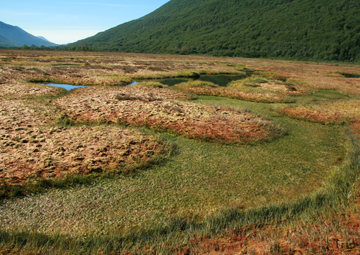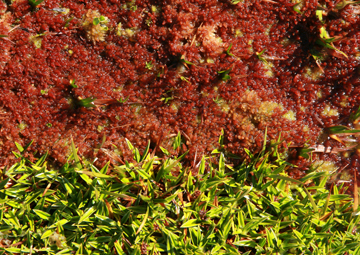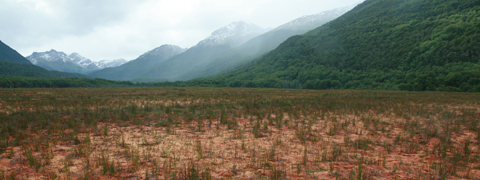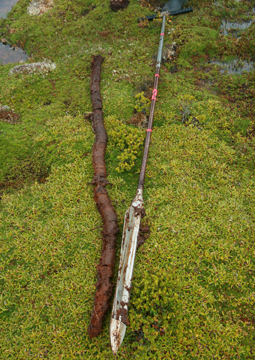CANDYbog
Carbon, water and nutrient dynamics in vascular plant- vs. Sphagnum-dominated bog ecosystems in southern Patagonia

Undisturbed Sphagnum-dominated bog. (photo: Till Kleinebecker) 
Sphagnum magellanicum and Astelia pumila side by side. (Foto: Till Kleinebecker) Background
CANDYbog: Matter fluxes in South Patagonian peatlands
The DFG-funded project CANDYbog (Carbon, water and nutrient dynamics in vascular plant- vs. Sphagnum-dominated bog ecosystems in southern Patagonia) deals with temporal and spatial patterns as well as processes controlling matter fluxes in South Patagonian peatlands. In contrast to their northern counterparts that are often heavily anthropogenically influenced and well-investigated, these pristine southern peatlands are only poorly studied. Therefore, South Patagonian peatlands allow for the investigation of matter fluxes under nearly undisturbed conditions which is almost impossible in the northern hemisphere.
Beside bogs dominated by peat-forming Sphagnum mosses that are also typical for the northern hemisphere, also bogs that are dominated by cushion-building vascular plants can be found in South Patagonia. So far, it is almost unknown which conditions lead to either the development of cushion bogs or Sphagnum bogs. Undisturbed bogs have an important carbon storage function in the global carbon cycle. However, the carbon source and sink dynamics of South Patagonian bogs have not been investigated so far and thus it is unclear, how much carbon is stored or released, particularly by cushion bogs. The aim of the CANDY bog project is therefore to quantify the carbon, nutrient and water balance of South Patagonian peatlands as well as to identify and better understand the key processes controlling nutrient and carbon dynamics in these peatlands.
Beside the relevance for the global carbon cycle, a better functional understanding of South Patagonian peatlands is particularly promising because they can be considered as model systems for undisturbed peatlands in the northern hemisphere. Therefore, South Patagonian peatlands can be particularly suitable to investigate the response of peatlands to changing environmental conditions, for example caused by global change including climatic changes or elevated atmospheric nitrogen inputs. It is expected that these changes in environmental conditions affect the vegetation composition and carbon storage function of peatlands. In this context, the cushion bogs may be an example of the expected changes in the vegetation composition of the northern hemispherical bogs towards a greater dominance of vascular plants. Thus, the results might give valuable insights for the conservation and restoration of bogs in the northern hemisphere.
The CANDY bog project is jointly organized by the working groups Ecosystem Research and Hydrology at the University of Münster, the working group Regional Hydrology at the University of Hamburg and our Argentinean partner from the Centro Austral de Investigaciones Científicas (CADIC) in Ushuaia (project partners and contacts are listed under “Info”).Among others, the research questions deal with:
- the differences in carbon and water balances between vascular plants and Sphagnum-dominated peatlands, especially in response to different environmental conditions
- the effects of experimental shading and fertilization on Sphagnum mosses and cushion-forming vascular plants, on peat decomposition rates as well as nitrogen dynamics
- the long-term carbon sequestration rate of South Patagonian bogs
Methods
In the CANDYbog project, a wide range of methods ranging from field measurements and experiments to laboratory experiments will be applied. During three extensive field campaigns in the summer months of Southern Patagonia both prevalent bog types will be intensively studied. The Sphagnum bog is situated close to Ushuaia in the Tierra del Fuego national park (postition in google maps), whereas the cushion bog dominated by Astelia pumila belongs to the Estanica Moat (position in google maps), a three hours car drive away from Ushuaia.
One focus of the field work is a shading and fertilization experiment to get detailed insights into the dynamics of nutrients, biomass production and peat decomposition of the two bog types. Subsequent laboratory studies include, for example, the analysis of stable isotopes, incubation experiments or spectroscopic measurements.
In order to measure and compare fluxes of energy, carbon and water between the two bog ecosystems and the atmosphere at different spatial scales, the micrometeorological eddy covariance method as well as closed and ecophysiological leaf chamber systems will be used. In addition, dissolved and particulate matter fluxes will be quantified using hydrological methods. These prevailing carbon balances of the two bogs types will then be compared with the long-term carbon sequestration rates determined by the analysis of peat profiles.
The investigations are planned in close cooperation with our Argentinean partners in Ushuaia which are particularly interested in the role of fungi for decomposition processes of organic matter. Therefore an Argentinean PhD student will perform specific investigations that will be integrated in the planned field and lab experiments.

In Tierra del Fuego, glacial valleys are often filled by extensive mires. (photo: Till Kleinebecker) 
In bogs dominated by vascular plants, roots reach up to 2m below ground. Sphagnum peat is often found in the lower parts of the soil profile. (photo: Till Kleinebecker) Students
News [april 2014]: We are currently looking for two Master students who would like to do their thesis on Temporal and spatial variability of CO2 and CH4 fluxes in Sphagnum and Astelia dominated bogs of South Patagonia.
Further topics for Bachelor and Master theses are available about the carbon and nitrogen dynamics of South Patagonian bogs!
Interested students are welcome to contact us to develop an exciting topic for a thesis within the framework of the CANDYbog project. It is also possible to join our next field campaign in winter 2014/2015 in Southern Patagonia. Participation in the project requires basic statistical and analytical laboratory knowledge, but mainly enthusiasm for our project. Basic knowledge of Spanish is an advantage but not a requirement to join our field trips.
If you are interested - also to support the project as a student assistant – contact Wiebke Münchberger.
Already during the first field campaign (December 2013 – April 2014), an undergraduate student joined us to collect data for his thesis. Aim of this study is a vegetation classification of the two bogs types with high-resolution multispectral images. These data will be then used to extrapolate the measured fluxes to the whole bog.
Info
Project partner and contact
University of Münster
University of Münster, Institute of Landscape Ecology, Working Groups Ecosystem Research and Hydrology
Principle investigators: Dr. Till Kleinebecker , Prof. Dr. Christian Blodau
PhD student: Wiebke MünchbergerUniversity of Hamburg
Institute of Soil Science, Working Group Regional Hydrology in Terrestrial Systems
Principle investigator: Prof. Dr. Lars Kutzbach
PhD student: Dipl.-Min. David HollCentro Austral de Investigaciones Científicas (CADIC), Ushuaia, Argentina
Principle investigator: Dr. Verónica Pancotto [es]
PhD student: Noelia Paredes [es]Radboud University Nijmegen
Institute for Water and Wetland Research, Experimental Plant Ecology
Dr. Christian FritzProject duration and funding
- Project duration: 09/2013 - 09/2016
- Funded by the German Research Foundation


